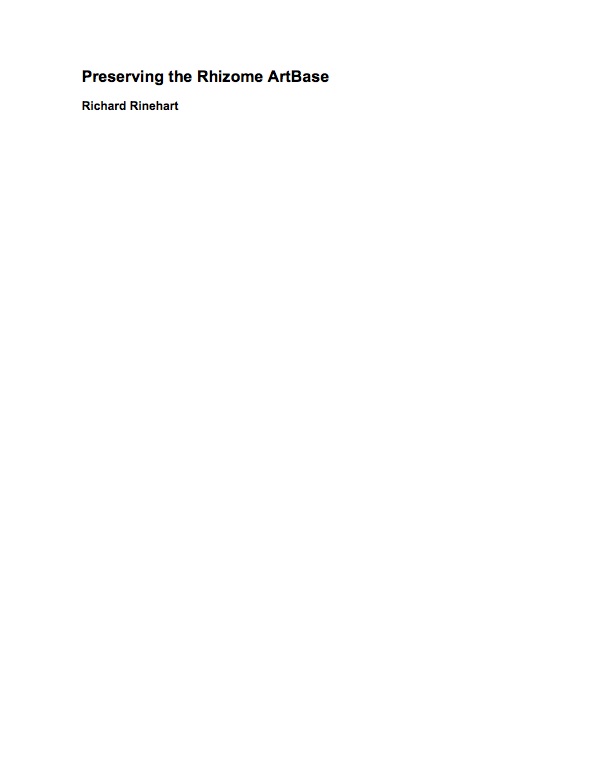Resource Guide Homepage
Resource Guide Homepage
Basic Questions
It is often difficult to know where to start a digital preservation project. The variables between different computer-based artworks, especially when compared to traditional media or even single-channel video, can be almost infinite. These variables are a primary challenge faced by preservationists working in the digital realm. The questions below address the basic points that must be considered at the start of any such project.
Sources
Caitlin Jones, "Seeing Double: Emulation in Theory and Practice"
Richard Rinehart, "Preserving the Rhizome ArtBase"
Bruce Sterling, "Digital Decay"
Documents are available to view at bottom of page.
What are the challenges of preserving interactive media?
New media is even more dependent on constantly changing technology than single-channel works. Computer hardware, software, operating systems, and storage media all routinely fail or become obsolete. In the 1980s, for example, laserdiscs allowed more variability than videotape, but today, laserdisc players are increasingly hard to find. CD-ROMs from less than ten years ago cannot be played on most current operating systems. Websites can change on a daily basis.
Moreover, the longevity of digital data, or bits, remains unproven. Digital files still require a physical storage medium, which may call for even more diligent management than film reels in a vault. As Bruce Sterling points out, in his article "Digital Decay," "Tape demagnetizes. CDs delaminate. Networks go down. There is a whole chain of additional failure points, inherent in the nature of contemporary computers."
For computer-based works, isn't saving the files enough?
No. Computer software and operating systems are constantly changing, often with multiple versions appearing within one year. These improvements are sometimes made with little consideration about how older media will play on new systems. How data will translate in the future is difficult to anticipate, and the look and feel of a work can vary greatly from system to system. Relevant software and operating systems must be saved along with the media files that use them, and/or the files should be migrated with very strict attention to quality control.
Is printing screen shots of a website enough to preserve the work?
While useful as documentation, screen shots do not retain the functionality or interactive possibilities of a web-based work. In addition to specific file types and media players, specific web browsers greatly affect how a work is experienced. It may be necessary to retain copies of software, operating systems, browsers, and plug-ins if they are integral to the functionality of a work. A web-based work may require migration to, or emulation in, a contemporary platform.
What does it mean to migrate or to emulate a work?
"Migration" is the most basic form of digital preservation. It simply means copying digital files to new storage media, while being careful to preserve all the qualities of the original work.
Emulation is more complex. To use a definition by the conservator Caitlin Jones: "To emulate a work is to devise a way of imitating the original look and feel of the piece through completely different means. The term can be applied generally to any refabrication of an artwork's components, but it also has a specific meaning in the context of digital media, where emulation offers a powerful technique for running a program from an out-of-date computer on a contemporary one."
Are there other ways to preserve digital works?
As Richard Rinehart has written, it might be possible to "[recreate] the work from scratch in contemporary media based on instructions from the artist, documenting the work with more stable media, and migrating the work to a newer standard or platform."
Digital Decay
The following is the transcript of Sterling?s keynote address at ?Preserving the Immaterial: A Conference on Variable Media,? which took place at the Solomon R. Guggenheim Museum, New York, on March 30?31, 2001.
Preserving the Rhizome ArtBase
This paper outlines the key steps Rhizome should consider taking toward preserving the works of art included in the Rhizome ArtBase, and indicates measures Rhizome may take in the near future to test the strategy of emulation in particular. It outlines a general method for preserving new media art. Although it discusses some of Rhizome?s current policies, it also includes steps, which may be impractical for Rhizome to take at this stage. Overall, this paper defines a research agenda for a long-term new media art preservation project to be undertaken by the arts and cultural community in the future, with the ultimate goal of developing solutions for the preservation of new media art. It is thus both a working paper for Rhizome and a map of Rhizome?s contribution to the larger effort to preserve artworks in digital and other variable media.
Seeing Double: Emulation In Theory And Practice The Erl King Case Study
As part of a larger program called the Variable Media Network, the Guggenheim Museum, in collaboration with the Daniel Langlois Foundation for Art, Science and Technology, has investigated a series of case studies to formulate creative strategies for endangered works. One work chosen to test emulation is Grahame Weinbren and Roberta Friedman?s video piece ?The Erl King? (1982-85). Heralded as one of the first works of interactive video art, ?The Erl King? invites the viewer to control the work?s narrative structure through the use of a touch-screen monitor. Due to its unique combination of obsolete hardware (both off the shelf and custom made) and artist-written software, ?The Erl King? presented itself as an ideal candidate for hardware emulation.


